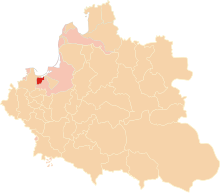Malbork Voivodeship
| Malbork Voivodeship Palatinatus Marienburgensis Województwo malborskie | |||||||||||
|---|---|---|---|---|---|---|---|---|---|---|---|
| Voivodeship of Poland¹ Part of Royal Prussia | |||||||||||
| 1466–1772 | |||||||||||
 Malbork Voivodeship of the Polish–Lithuanian Commonwealth | |||||||||||
| Capital | Marienburg | ||||||||||
| Area | |||||||||||
| • Coordinates | 54°02′21″N 19°01′39″E / 54.039205°N 19.027598°E | ||||||||||
• | 2,096 km2 (809 sq mi) | ||||||||||
| History | |||||||||||
• Prussian uprising | 1454 | ||||||||||
| 9 October 1466 | |||||||||||
| 1569 | |||||||||||
| 1772 | |||||||||||
| Political subdivisions | Counties: 4 | ||||||||||
| |||||||||||
| ¹ Voivodeship of the Polish Crown in the Polish–Lithuanian Commonwealth; Voivodeship of the Kingdom of Poland before 1569. | |||||||||||
The Malbork Voivodeship (Polish: Województwo malborskie), after Partitions of Poland also referred to as the Malbork Land (Polish: Ziemia malborska), was a unit of administrative division and local government in the Kingdom of Poland from 1454/1466 until the partitions in 1772–1795. Together with the Pomeranian and Chełmno Voivodeships and the Prince-Bishopric of Warmia it formed the historical province of Royal Prussia. Its capital was at Marienburg (Malbork).
History

| History of Brandenburg and Prussia |
|---|
  |
|
| Present |
|
After the Teutonic Knights during the 13th century had conquered the Prussian territories and incorporated them into the Order's State, the castle of Marienburg served as the seat of the Grand Masters. Following the 1410 Battle of Grunwald, the Knights once again could withstand the Polish Siege of Marienburg. However, after the uprising of the Prussian Confederation in 1454 (in which Marienburg did not participate) and the outbreak of the Thirteen Years' War with the Kingdom of Poland, they had to withdraw to Königsberg and after their final defeat lost the castle and the surrounding territory in the 1466 Second Peace of Thorn.
King Casimir IV Jagiellon of Poland annexed the territory and established the voivodeship of Marienburg, including the towns of Elbing (Elbląg), Stuhm (Sztum) and Christburg (Kiszpork, later Dzierzgoń). Since the 1569 Union of Lublin the Lands of the Polish Crown were part of the larger Polish–Lithuanian Commonwealth. Marienburg Castle was occupied twice by troops of the Swedish Empire: during the Thirty Years' War 1626–1629 and again from 1656 to 1660 during the Second Northern War. In 1772, the voivodeship was annexed by Prussia in the First Partition of Poland and became part of the newly established Province of West Prussia the next year.
Zygmunt Gloger in his monumental book Historical Geography of the Lands of Old Poland provides this description of Malbork Voivodeship:
"The smallest of three voivodeships of Polish Prussia, it was divided into four counties: Sztum, Kiszpork, Elblag and Malbork. Local starostas resided at Kiszpork, Sztum, Tolkmicko, and other locations. Sejmiks and courts were not located at Malbork, but at Sztum, which itself was governed by the starosta of Kiszpork. At sejmiks, local nobility elected eight deputies to the Prussian Sejm, e.g. two from each county (...) Malbork Voivodeship’s coat of arms was almost identical as Chelmno Voivodeship's, with differences in color of the eagle. The Prussian Sejm took place alternatively at Malbork and Grudziadz".
Administration
Voivodeship Governor (Wojewoda) seat:
Voivodes list:
- Ścibor Bażyński/Stibor (Tiburcius) von Baysen 15 June 1467 – 1480
- Mikołaj Bażyński/Niklas von Baysen 23 February 1481 – 27 March 1501
- Maciej Raba 21 August 1512 – 1546
- Achacy Czema 1546 – 24 May 1564
- Fabian Czema 1566–1580
- Fabian Czema (younger) 1581-22 August 1605
- Jerzy Kostka 1605–1611
- Stanisław Działyński 1611–1615
- Jan Wejher 1615–1618
- Stanisław Konarski 1618–1625
- Samuel Żaliński 3 November 1625 – 6 October 1629
- Samuel Konarski 30 November 1629 – 1641
- Mikołaj Wejher 11 October 1641 – 20 May 1643
- Jakub Wejher 20 May 1643 – 21 February 1657
- Stanisław Działyński 30 March 1657 – 1677
- Jan Ignacy Bąkowski 1677–1679
- Jan Gniński 1679
- Franciszek Jan Bieliński 1681–1685
- Ernest Denhoff 1685–1693
- Władysław Łoś 1694
- Jan Jerzy Przebendowski 17 September 1697 – 9 February 1703
- Piotr Kczewski 9 February 1703 – 20 November 1722
- Piotr Przebendowski 21 November 1722 – 1755
- Jakub Działyński 27 May 1756 – 17 September 1772
Regional council (sejmik generalny):
The Voivodeship was divided into four powiats (counties or administrative divisions):
- Sztum County, (Powiat Sztumski),
- Kiszpork County, (Powiat Kiszporski),
- Elbląg County, (Powiat Elbląski),
- Malbork County, (Powiat Malborski).


